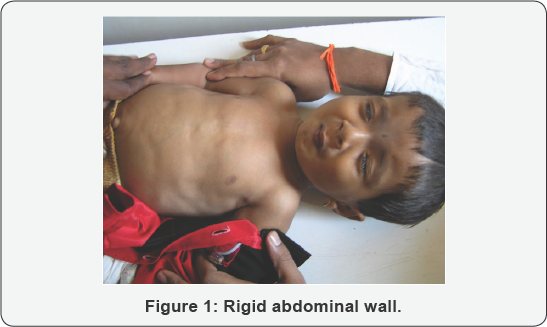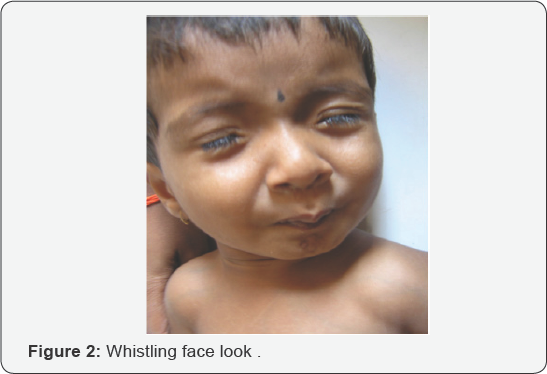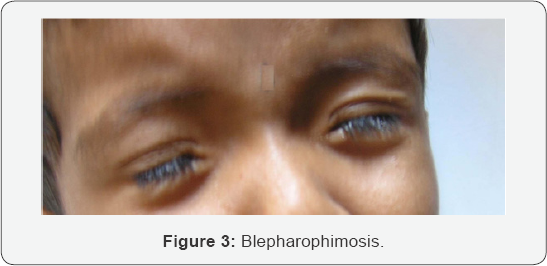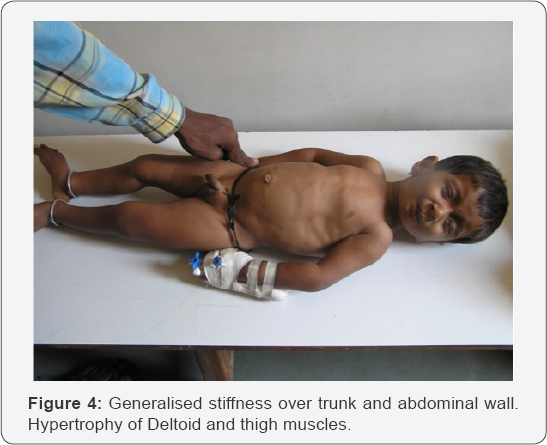Juniper
Publishers- JOJ Ophthalmology
Itroduction
Blepharophimosis is a general diminution of palpebral
fissure in all its dimensions. The lids usually show ptosis, dystopia
canthorum, lateral displacement of the lateral puncti, or abnormalities
of the lashes such as ditichiasis or misdirected and stiff lashes. The
other ocular defects associated with congenital blepharophimosis include
strabismus, nystagmus, amblyopia, microphthalmus, anophthalmus,
epicanthus inversus, microcornea and hypermetropia [1,2]. Schwartz-Jampel syndrome, an autosomal recessively transmitted disease, is a rare presentation of blepharophimosis.
Case History
A 2 year old male child, having dysmorphic features
was referred from the department of Pediatrics for Ophthalmic
assessment. The child was the first born of healthy non- consanguineous
parents after an uneventful pregnancy. His mental and motor development
was normal and he acquired independent walking at 16 months. Fine pincer
grasp developed by 9 months of age. At the age of 2 years the child
could talk only two words with meaning. Social development of the child
was poor because of his abnormal appearance and poor language
development. The parents noted the abnormal facial expression at the age
of 18 months.
On examination the child had a short stature. The
head posture was normal. Forehead did not show excessive wrinkling. The
child had blepharophimosis (Figure 1).
Lid crease was present. The child also had hypertrichosis. The globe
examination was normal. The extraocular movements were normal. There was
no refractive error. Fundus was normal. The child demonstrated pursing
of lips giving him a 'whistling face' appearance and restricting his
mouth opening (Figure 2). The shape of the chest was abnormal with sternal protrusion and sub-costal retraction (Figure 3).
There was stiffness of his abdominal wall. The upper and lower limbs
demonstrated hypertonia. The deep tendon reflexes were exaggerated. He
had a waddling gait. The child had a high pitched voice (Figure 4).




Discussion
Schwartz-Jampel syndrome is a rare autosomal
recessively transmitted disease, characterized by generalized myotonic
myopathy, typical facial features, skeletal dysplasia, contracture of
joints, growth retardation and bone maturation delay [3].
However a few cases showing dominant inheritance have also been
reported. It is classified into 3 types based on age and severity
- Type 1A
- Type 1B
- Type 2
Type 1A
The type 1A disease is diagnosed in mid-childhood
with recognition of myotonic facies with convex profile, short palpebral
fissure, telecanthus, dimpling or quivering of the chin, prominent
eyebrows, low hairline, low-set ears, flat base of the nose,
micrognathia, microstomia, sometimes high-arched palate. The child
exhibits progressive myotonia, muscle wasting and orthopaedic problems
with decreased linear growth myotonia plateus by mid childhood.
Additional findings reported in a few cases are myopia, hypertrichosis,
and strabismus. The continuous myotonia is probably responsible for both
muscular hypertrophy and peculiar facial appearance.
Type 1B
Type 1B is more severe than 1A, Bone dysplasia is present at birth.
Long bones are shortened, femurs are dumbbell shaped. Bone epiphyses are
large and vertebral bodies are flat.
Type 2
Type2 disease is more severe. Onset is neonatal,
there is short limb dysplasia and long bones are bowed. Early death is
frequent [4].
The diagnosis is predominantly on the basis of the typical dysmorphic facies [5].
EMG showing continuous discharges further supports the diagnosis. The
gene defect in SJS type 1 is located in the 1p34-p36 of chromosome 1,
whereas it is different in type 2 [6,7]. Perlecan the major proteoglycan of basement membranes is altered in patients with Schwartz- jampel syndrome disease [8].
However, a significant amount of molecular heterogeneity exists,
genomically and proteomically, within SJS type 1. Currently no known
correlation exists between the specific mutations found and the specific
features of a given case However, the new mutations found by Stum et
al. In 2006 have been discovered so recently that not enough time has
elapsed to explore such possibilities. The new findings should be
important tools to help find correlations among genetic variants,
perlecan forms and levels, and clinical subtypes. Other facts yet
unknown also may influence the severity and the specific characteristics
of the disease [5]. The genetic tests for perlecan gene are not easily available in the commercial laboratories.
The child was diagnosed as having type 1A type of
Schwartz- Jampel syndrome since the typical facial features became
manifest at the age of 18 months. The old pictures of the child taken on
his first birthday showed normal facial features. Medications that have
been found useful in myotonic disorders such as phenytoin and
carbamazipene may help to reduce the abnormal muscle activity. Warm
baths are helpful in reducing stiffness. Botox injections are reportedly
found useful to relieve blepharospsm.
Patients are generally treated with Carbamizipene
2030mg/kg body weight and most of them show improvement. Carbamazipene
probably works by inhibiting neuronal sodium channels and may have
direct effects on neurotransmitter systems. Orbicularis oculi myectomy,
levator aponeurosis resection and lateral canthopexy are some surgical
procedures which may be tried if the response to carbamazipene or botox
is not adequate. The parents of the child were educated regarding the
genetic nature of the disease and were referred to the geneticist. This
particular child has not reported for follow-up as he belongs to a
remote village far from our hospital and is probably reporting for
follow-up at a nearby city.
Conclusion
Schwartz-Jampelsyndromeisararecauseofblepharophimosis. The condition can
be managed with medications in most of the? cases. Surgery may be
required if the condition does not improve with drugs.
For more articles in JOJ Ophthalmology (JOJO) please click on: https://juniperpublishers.com/jojo/index.php
No comments:
Post a Comment